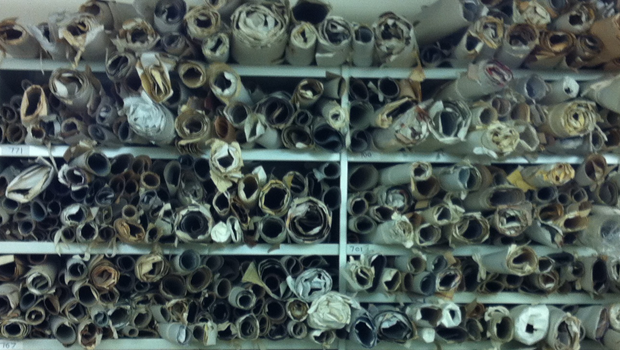Whilst this rather tatty and uncoordinated mess (pictured) doesn’t look like much, it is a glimpse behind-the-scenes at Wolverhampton Archives.
The photograph was taken in our Accession Room, which is in an area towards the rear of the building. This Room is the place where records are placed when they first arrive at the Archive.
The Accession Room has enough floor and desk space for archivists to sort through and re-box the material, before transferring it to our archival strongrooms. Material in the Accession Room has not yet been catalogued, and is therefore not available for research.
These are, in fact, the plans from planning applications, submitted to Wolverhampton City Council and its predecessors, including Wednesfield Urban District Council. These plans date from 1881 right up until 1992, and more are being catalogued all the time. As you can imagine, the number of planning applications submitted to the Council every year is vast, and we simply do not have the space to store them all. Instead, every year as part of our Closed stocktaking fortnight (This year 3 rd – 15th December inclusive), one of our tasks is to weed out the plans that we want to keep. We have a set of strict criteria – standard kitchen extensions, conservatories and garages are disposed of, unless they are for particularly significant properties. What we end up with is a set of plans for many of the noteworthy and prominent buildings and developments in the City.
Although this annual appraisal (as the weeding out is called) has been going on for many years, many of these plans are still not available on the catalogue, but I am in the process of changing that.
The Wednesfield plans are catalogued under the reference of WP (post-1966) and D-WED (pre-1966). Some of the plans I have recently unearthed include ones for the Ashmore Park Estate, the Cottage Homes in Amos Lane, and local schools including Coppice Farm and Deansfield. The plans are fascinating, often with detailed floor layouts of the property. Keep checking back on the Black Country History website (www.blackcountryhistory.com), as more are being added all the time!
